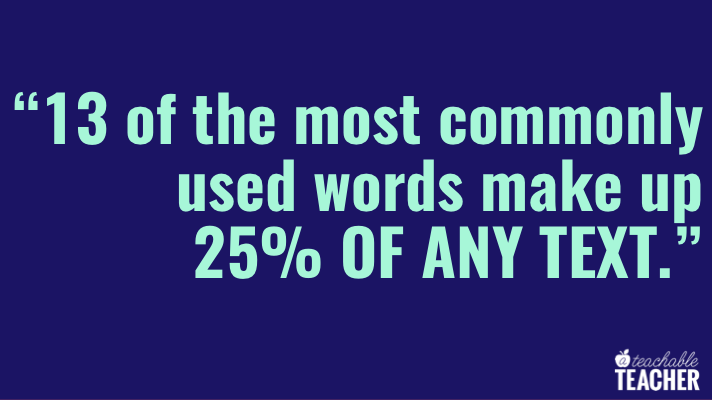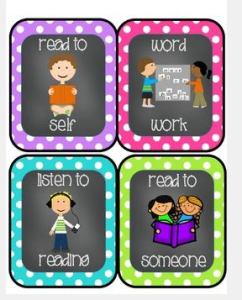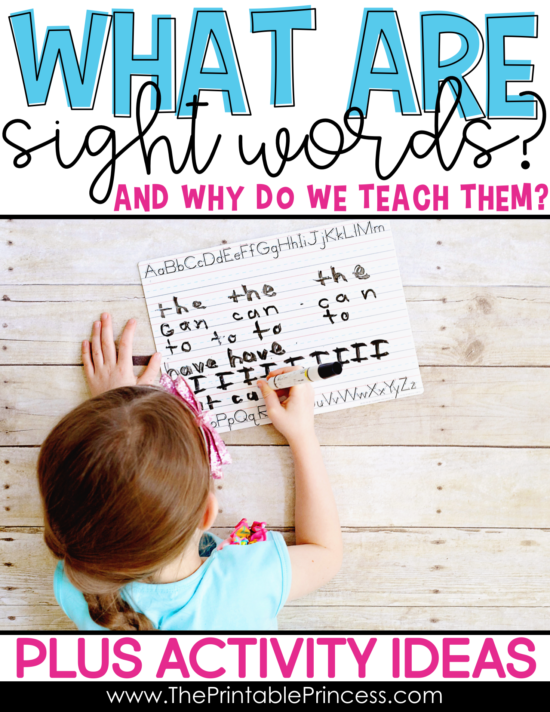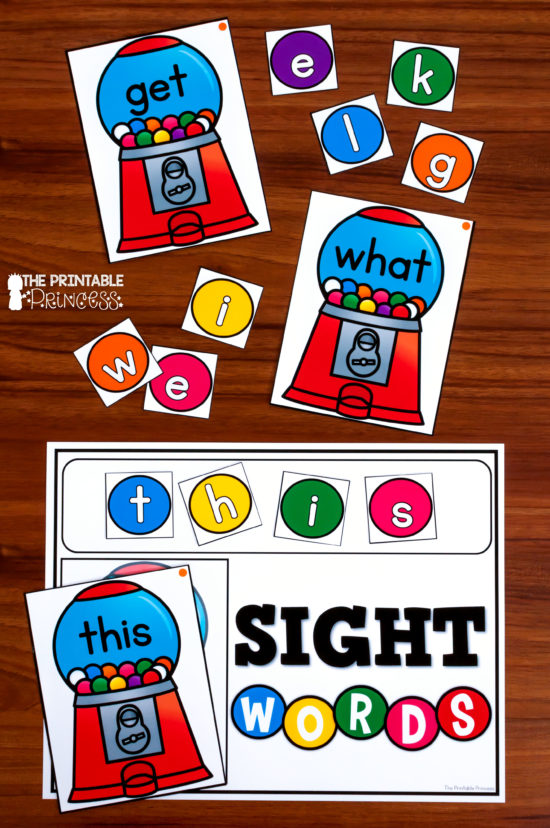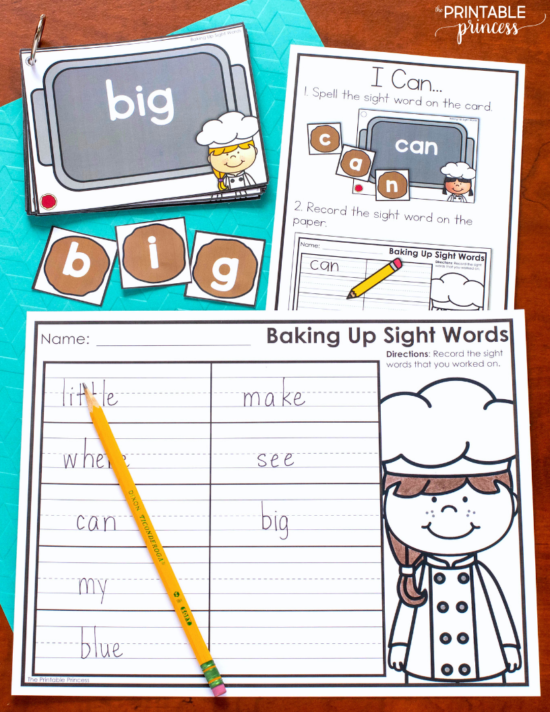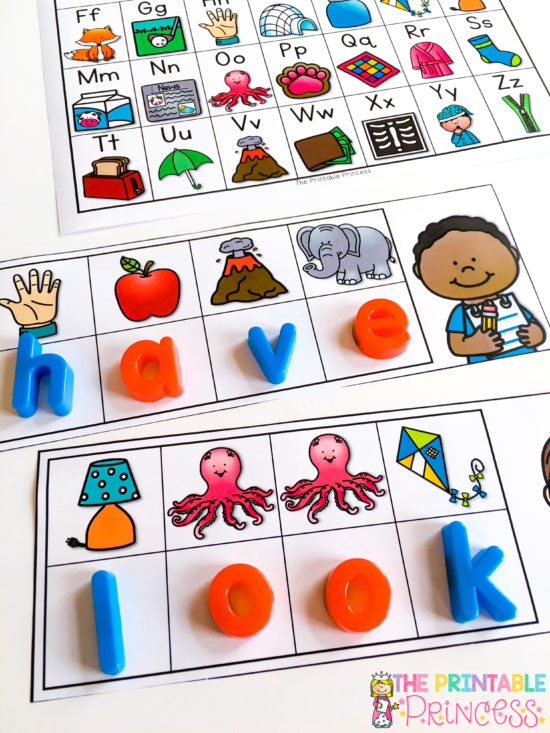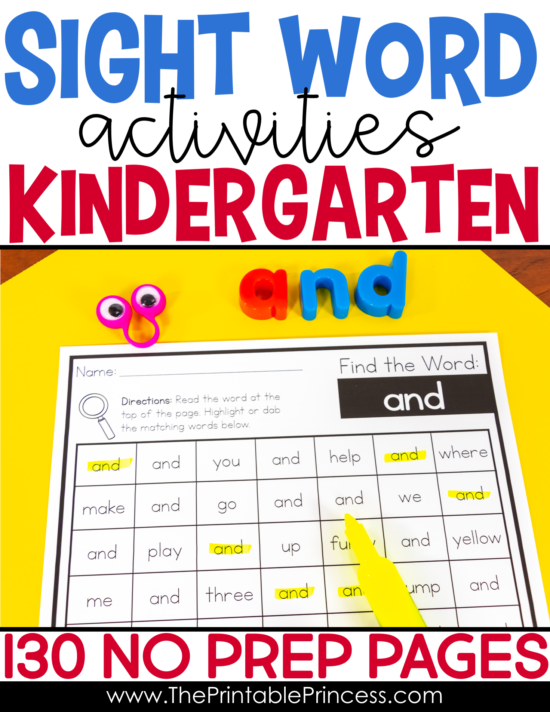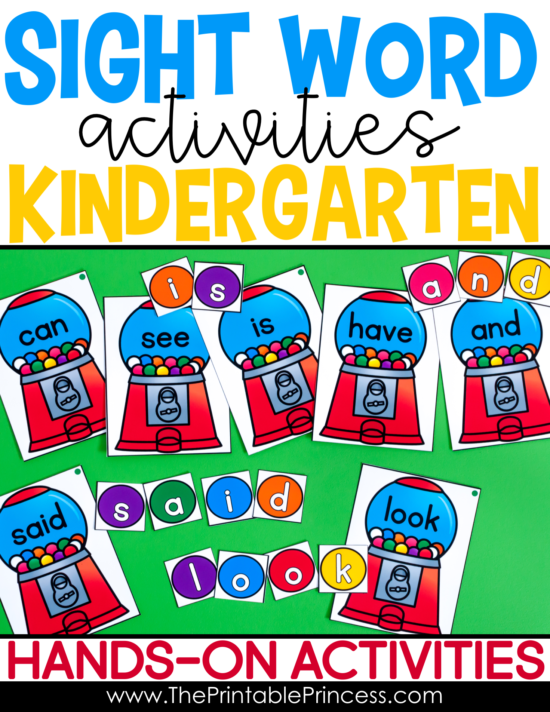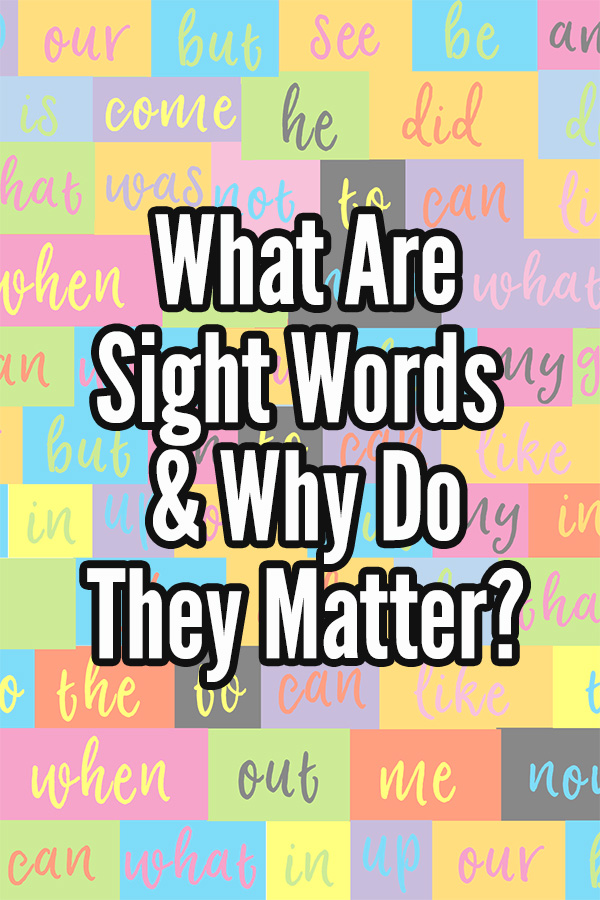Sight words and high frequency words are a huge component of reading instruction, yet the difference between the two is rarely discussed. Here’s how learning the difference between the two has changed my reading instruction – for the better!
Have you really thought about your list of sight words and high frequency words?
I was just talking to a teacher friend and she also mentioned that her district had just updated theirs.
Why would they need to update their list? I wondered.
That sent me down a rabbit hole of wondering.
Why are there so many variations of sight words and high frequency words lists?
Why do the lists vary from district to district?
Why would a list need to change?
Why, why, why?
Once my head stopped spinning? I researched and found some really interesting answers about sight words VS high frequency words that helped shape my instruction.
The Difference Between Sight Words and High Frequency Words
It turns out, sight words and high frequency words are different from each other. 🤯
I had always assumed that they had different names, just like the “Fry’s” and “Dolch” lists. Yeah, that’s not why they differ! 🤦🏽♀️
What’s a Sight Word?
A sight word is a word that does not follow the rules of spelling or syllables. These words are not decodable.
I knew this already! So then that begs the question…
What is a high frequency word?
A high frequency word is a decodable word that students need to know in order to be fluent readers.
But…. (there’s always a but you know…)
These words may follow rules that a student will not learn until after they “need” to know them.
Examples of Sight Words and High Frequency Words
The is a sight word. It does not follow a decodable spelling pattern. In other words, no matter how much phonics you have taught your students, they’re not going to be able to sound it out.
(Tell me I’m not the only teacher who has watched a student try to sound out the during an assessment. 🤪)
Like is a high frequency word. But it does follow the typical CVCe pattern.
However, a student will probably read the word like when they are decoding CVC words!
I like the cat.
They’re focusing on decoding CVC words. So it’s not the time to throw in the sneaky, magic, bossy, silent, whatever-you-want-to-call-it e.
Clearly, both of the words (the – sight word; like – high frequency word) are important for new readers to know early on in their reading instruction because they are very common.
Thus, both types of words (sight words and high frequency words) should be memorized.
Sight Word and High Frequency Word History
The Dolch sight word list was developed in 1937 by Edward Dolch. He included a mix of sight words and high frequency words that he said should be memorized to increase reading ability.
He also believed, (and now research proves), that these words could be stumbling blocks for new readers. If they memorized them, they would become more fluent than if they had to decode them each time they read them.
13 of the most commonly used words make up 25% OF ANY TEXT. 😳
100 of the most common sight words and high frequency words make up 50% OF ANY TEXT. 😳😳
Now you’re probably thinking…No wonder these words are so important!
What does this mean for our reading instruction?
Your class has been working so hard to sound out CVC words. They’re killin’ it! Yay!
Now you put this sentence in front of your student.
The cat is big!
Student: /t/ /h/ /e/, t-huh-e, te?
Teacher: Don’t sound it out!
Student: Huh?
I mean, I get why the student is confused! All they’ve been doing is decoding three letter words and now you’re also telling them not to sound it out! 🤦🏽♀️ #thanksEnglish
Clearly, students may misunderstand which words should be memorized vs. sounded out.
They may mistrust the process of learning phonics skills when they don’t always work.
They may give up.
Obviously this is not what we want. In fact, we want to encourage and empower our new readers! 👏
Explaining the Difference to Your Students
I do this by explaining the difference between sight words, high frequency words, and decodable words.
I also encourage them that they are doing a great job sounding out words!
Then I tell them that English is sooo tricky! It’s also a good thing they have big, strong brains and English is NOT going to fool them! 🧠 #growthmindset
I tell them that some words are just tricky rule breakers that you can’t sound them out! Those are sight words. That’s why we have lists, and practice them, and memorize them!
Then I tell them that there are “first grade words” (or whatever the next highest grade is) that they’re going to learn to read early! They have to memorize those words, too. Those are high frequency words. (This gets them soooo excited. They feel so smart because you trusted them with a first grade word. 🤓)
We look for these words in our books, on posters, on the computer. When we find them we cheer! We know these words! #empoweredreaders
We know sight words are important. We know high frequency words are important. If we can impress that upon our new readers, then we are giving them ownership of their learning. What could be better than that? 🙌
Do you have a discussion like this with your new readers? How do you like to teach sight words and high frequency words? I would love to hear your ideas. Let me know below 👇
Like many families this week, your children are heading back to the classroom and coming home with a worksheet or two of homework. (Make that dozens of worksheets for your older kids!) The homework that caught my eye this week is the list of “sight words.” What are sight words? Sight words (high-frequency words, core words or even popcorn words) are the words that are used most often in reading and writing. According to Teach Stix:
In classrooms across America, the development of sight word recognition continues to be a top priority when instructing emerging and beginning readers.
They are called “sight” words because the goal is for your child to recognize these words instantly, at first sight.
Why are Sight Words Important?
Sight words are very important for your child to master because, believe it or not, “sight words account for up to 75% of the words used in beginning children’s printed material”, according to Study to Identify High-Frequency Words in Printed Materials, by D.J. Kear & M.A. Gladhart. There are different sight words for every grade level. Each set of words builds upon the other, meaning that once your child learns the sight words in Kindergarten, he will be expected to still recognize those words as he learns new words in first grade, and so forth.
Many of the over 200 “sight words” do not follow the basic phonics principles, thus they cannot be “sounded out.” Beginning readers need an effective strategy for decoding unknown words, and being familiar with sight words is an effective method. Other benefits of sight words include:
- Sight words promote confidence. Because the first 100 sight words represent over 50% of English text, a child who has mastered the list of sight words can already recognize at least half of a sentence. If your child begins to read a book and can already recognize the words, chances are he won’t feel discouraged and put the book down, rather he’ll have more confidence to read it all the way through. And, choose another!
- Sight words help promote reading comprehension. When your child opens her book for the first time, instead of trying to decipher what ALL of the words mean, she can shift her attention to focus on those words she is not familiar with. She will already know at least half of the words, so focusing on the other half helps strengthen her understanding of the text.
- Sight words provide clues to the context of the text. If your child is familiar with the sight words, she may be able to decode the meaning of the paragraph or sentence by reading the sight words. And, if a picture accompanies the text, your child may be able to determine what the story is about and come away with a few new words under her belt.
How to Practice Sight Words
You will want to become familiar with all of the sight words for each grade. Both the Dolch List of Basic Sight Words and Fry’s 300 Instant Sight Words, each of which can be downloaded from the Literacy and Information Communication System (LINCS) website. The key to mastering the list of sight words? Practice and repeat! The more opportunity your child has to become familiar with these words, the better. Of course, you’ll see sight words come home in the homework folder, or you may even be asked by the teacher to use flashcards, but there are many FUN activities and games that you can do together to help promote learning of the sight words.
Educational website, Ed Helper has an extensive collection of printables and worksheets designed to help kids conquer their list of sight words. Even Pinterest has jumped aboard with creative ideas to help your child work on sight words. There is an entire Pinterest site dedicated to sight word activities for your kids! Think Skittles, snowballs, chalkboards…the choices are endless! Take a look!
Creative Ways to Conquer Sight Words. Pinned Image from teacherspayteachers.com
Sight words help your child build a foundation for reading comprehension and fluency. How about using online tools to help perfect those words? Most kids will welcome the chance to “play” online, even if it is educational. Our new Bitsboard app is a great way to target certain sounds and sight words in an engaging way. Enjoy!
Language Development
Beginning readers use many different strategies to become more fluent readers. One of the most important methods is learning to read and recognize sight words. These are basic words that are memorized rather than sounded out. Part of the process of teaching children to read, often starting in kindergarten, focuses on sight words.
Shannon Fagan / Getty Images
What Are Sight Words?
Sight words refer to the words that are most frequently used and repeated in books, which is why sight words are also sometimes referred to as “high-frequency” words. The same words are also sometimes called “core words” and “popcorn words.” The phrase «popcorn words» refers to the fact that they tend to «pop» out at students every time they see the words.
It’s estimated that some 100-200 words make up more than 50% of the text that students read. It sounds rather implausible until you consider that sight words are often the small, easily recognizable words like “a, I, or, and, the” and so forth.
A sight vocabulary is a list of words that the individual reader knows by sight, without having to decode them or do any kind of word analysis.
Sight Word Lists
Teachers rely on a few different lists to come up with appropriate sight words for each grade level. In the early grades, you may see that your child’s teacher has included all of the students’ names on their sight word list. While not technically “sight words,” they are words that will be seen in the classroom over and over again, and it will be helpful for the students to recognize them.
Most sight word lists are comprised of words found on the Revised Dolch List of Basic Sight Words and Fry’s 300 Instant Sight Words, so you may also hear them referred to as Dolch or Fry words.
Each grade level has its own set of sight words to learn, and they build on one another. That means once your child has learned the words for kindergarten, they will be expected to know those words in addition to the new ones introduced in first grade. Learned words can help children decode new words. This technique is known as scaffolding.
Sight Word Games
You can work with your child at home to develop sight word recognition. Try one of the games below to make learning sight words fun for you and your child.
Flashcards: You can print flashcards to use for the assigned sight word list or purchase sets of flashcards recommended for different grade levels.
Bingo: Sight words bingo can be played with printable bingo cards, or you can make your own. Students will become familiar with the words while playing the game, and you can reward them to make it fun.
Hangman: Sight words hangman is an easy game to enjoy with one or more students.
Word Catchers: This activity uses a fly-swatter with a window cut out. When you are reading with your child, race to see who can catch one of the sight words first with the word catcher. You can decide on one or more words to target, and use a favorite book or a magazine or newspaper.
Beach Ball Toss: Mark a sight word on each section of an inflatable beach ball, then toss the ball around a circle of children to read the word that is facing them when they catch it.
Other ideas include playing Go Fish with sets of sight word cards, memory games, bean bag toss games, and laying out sight words in a pathway to follow.
A Word From Verywell
You can begin reviewing sight words with your child whenever they become interested in reading. But don’t worry if your preschooler or kindergartener isn’t ready for this step or isn’t grasping sight words quickly. Each child will progress at a different pace, and there is no need to rush them into reading.
Thanks for your feedback!
Learning to read is obviously tricky business. There are so many skills and strategies that need to come together to create fluent readers. One of the first steps in helping our young students get started is focusing on sight words.
But before we talk about HOW to teach sight words and share some sight word activities – let’s answer the questions: what are sight words? and why is it important to teach sight words?
This article, along with many other articles on The Printable Princess, contains Amazon affiliate links. If you purchase through the link I earn a small commission. Clicking these links does not cost you any extra but helps this website to keep great articles and freebies coming your way.
Believe it or not, at least 50% of texts are made up of the same frequently used 100 words! We call these commonly used words ‘sight words’. Most of them are small and easily recognized, (I, is, the, and, to) but some of them cannot be easily sounded out or illustrated (like, from, what, good).
Using phonics or picture-reading skills for words like these is ineffective for young readers, especially for those who are in the early stages of developing their decoding skills. Therefore we need to know these words by “sight”.
Why is it important to teach them?
It’s critical to teach students to memorize sight words as a whole so that they can recognize them immediately (within 3 seconds) without having to use any strategies to decode them. Imagine how frustrating reading would be if you had to stop and sound out every little word!
Once readers master sight words they are able to understand at least half of the words in any particular text. By eliminating the need to stop and decode sight words, readers are able to focus on words that are less familiar and more difficult.
And teaching sight words not only helps students read more fluently, it helps them write more efficiently too.
What is the best way to teach sight words?
If you were to ask this question to five teachers, you would probably get five different answers. But I think that we all would agree that the best way to engage young readers is to make sight word learning fun and hands-on.
Using sight word activities like games, centers, and hands-on manipulatives will help your students master skills without even knowing that they are learning!
Make sight word learning a regular part of your literacy block and switch out activities often. By setting aside time for focused attention on sight word learning, you’ll be surprised how quickly your young readers blossom.
Here’s a few of my favorite sight word activities…
Sight Word Activities
Magnetic Letters:
Using magnetic letters to spell sight words is a simple, hands-on way for kids to practice reading and building sight words. Simply write the words on flashcards and have students build the words.
To make these types of sight word activities extra fun, display the words on your white board so that students can build the words on your teacher board. Plus this make a great center activity!
Editable Sight Word Activities:
Have you ever met a kid that doesn’t like bubble gum or cookies? Me either! So why not use their love of yumminess to practice building sight words? Students read the sight word on the card and use the theme letter cards to build the word.
The Editable Gumball activity and Editable Baking Up Cookies activity come with 133 pre-made cards and an editable version so you can add your own words. It includes a themed work mat to give students a space to build their words and a recording sheet to hold students accountable.
Play Swat:
For this sight word activity all you need is a fly swatter! This game is great for building speed with identifying sight words. This game works well as a small group or whole group activity. To set up the game, you’ll need to write a few sight words on the board. Select one student to play. Call out a sight word and have them quickly swat the word.
To make the activity more challenging, call two students up and let them race to be the first to swat the sight word. (You could also adapt this activity to practice letters, numbers, etc)
Secret Code Sight Words:
This is one of my favorite sight word activities to spice up learning. This activity is always a hit because students have so much fun cracking the code that they don’t realize they are actually learning sight words. Students identify the beginning sound of each picture to crack the code and spell a secret sight word. They use dry erase markers, magnetic letters, or letter tiles to build the word and then read it.
The purpose of Secret Code Sight Words is not to sound the word out, but to build the word and then have students recognize the word they built.
Flip and Read Game:
I first shared this game as a fall alphabet game. But I’m sharing again because you really can practice any skill with it. The kids love it and it’s perfect for small groups.
You’ll need themed shapes (like the kind from a die-cut machine) and manipulatives or mini erasers. To prepare this game you’ll want to write a sight word on each of the themed shapes.
To play the game, turn the shapes face down. Put 1 or 2 manipulatives/game pieces on each shape. Students select a shape, turn it over, and if they can read the sight word they keep the manipulatives. At the end of the game, whoever has the most game pieces wins!
Shaving Creme:
If you don’t mind a little mess, this sight word activity works well to reach tactile (or hands-on) learners. Plus I love the way a classroom smells after a shaving creme activity. Just put a small amount of shaving creme on a cookie sheet or a plastic plate for the students to write the words in.
You’ll call out a sight word and students will use their finger to write the word in the shaving creme. Walk around the room to check their work or write the word on the board so that students can check their own work.
If you’re using shaving creme for the first time you’ll want to have a quick class chat about how to use shaving creme. I have three basic shaving creme rules.
1. Students should avoid touching their eyes and face with shaving creme.
2. Students need to be gentle and not slap their hand down in the shaving creme.
3. Lastly, we keep our own shaving creme. We don’t touch others with shaving creme and we don’t take shaving creme away from our friends.
Find the Word:
This is a fun activity because students get to use highlighters, which keeps them engaged! Give students a magazine or a newspaper page and have them highlight a target sight word that you’ve selected. Or use pages like the ones pictured below.
Students read the target sight word at the top of the page and then use a highlighter (or bingo dabber) to highlight the corresponding words below. Find the Word includes over 130 no prep pages.
Magazine Hunt:
This is another easy peasy center activity. Simply pick a sight word that you’d like students to work on. Give them a blank piece of paper. Students will look through the magazines to find that sight word. Once they’ve found it, they will cut it out and paste on the blank page. (Just be sure to preview the magazines before giving them to students.)
Build a Word:
Blocks or snap cubes are also a fun way to practice building sight words. Students link the blocks together to spell a word. For step-by-step directions and a free recording sheet for this sight word activity, check out this blog post.
Sky Writing:
Some of the best sight word activities require no prep or materials – like this one. Call out a sight word and spell it or have a student spell the word. Then have students put their pointer finger up and make BIG motions to “write” the words in the air.
As with everything that we teach our little learners, it takes repeated exposure and repetition to master sight words. That’s why I think it’s important for us to have several different ideas up our sleeves. I hope these suggestions gave you some fun and fresh activities for helping your little readers master sight words.
Until next time,

What are sight words?
Sight words, or high frequency words as they’re often known, are vocabulary words that appear frequently in verbal and written communication – words such as the, come, to and where. Unfortunately for those learning to read, many of these words are irregularly spelt, making them difficult to sound out phonetically.
Why is it important to learn sight words?
As children read, if they stop to phonetically decode a word the flow of text is interrupted, and comprehension of what has been read can be lost as the reader’s focuses on the task of decoding. It is for this reason that most reading programs recommend that children develop the ability to recall high frequency words automatically or ‘on sight.’ Children with a good grasp of the most regularly used sight words are able to read more fluently which, in turn, supports good reading comprehension.
What is the Dolch Sight Word List?
There are many different sets of sight words commonly used in schools and reading programs – the Dolch Word List, Fry’s Instant Words and the Magic 100 words are all very popular. The Dolch Word List is a list of common vocabulary developed by Edward William Dolch in 1936. Dolch sourced these words by studying the vocabulary of popular children’s books. These words are believed to represent between 50% and 75% of all vocabulary used at a grade school level.
How many words are in the Dolch Sight Word List?
The Dolch word list contains 220 non-nouns divided into five groups, and an associated list of 95 high frequency nouns. The non-nouns are divided into five levels of difficulty;
Pre-Primer – 40 words
Primer – 52 words
First grade – 41 words
Second grade – 46 words
Third grade – 41 words
How to teach sight words?
Typically, when children begin to learn to read sight words they start with small subsets or lists of 5-10 new words at a time, moving on to a new set of words once each previous set is mastered. Mastery generally involves lots of repetition, but it definitely does not have to be dull or boring! An average reader needs around 30 exposures to a word for recall to become automatic. Even a good reader needs around 20 exposures to each word. Exposing children to sight words in a variety of different ways and formats, both in context and in isolation, is it important to sight word mastery. There are many fun and interesting ways to expose a child repeatedly to a word without relying on flashcard drills.
Game playing is one of our favourite ways to develop sight word recall. Games are fun and engaging, and children often do not realize how much they are learning when they are having fun playing a game with a friend or family member.
You will find a great selection of printable sight word games in our Sight Words Games pack.
The pack provides 16 different games for revising sight words. They are suitable for home and school, working well as homework revision tasks and for small group work. As with all early learning, adding a touch of fun or playfulness to practice time can help to engage a child’s interest in the learning experience.
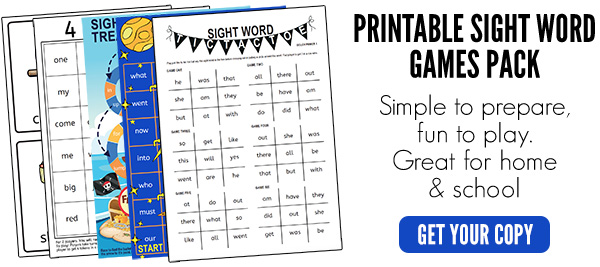
Christie Burnett is a teacher, presenter, writer and the mother of two. She created Childhood 101 as a place for teachers and parents to access engaging, high quality learning ideas.
This post contains affiliate links.
If you are not a teacher (or even if you are!), you have probably asked yourself at some point, “What are Sight Words, and why are they so important?!” As a former Kindergarten teacher who taught students to read and write every day, I am here to tell you: Sight Words are SO important! Here’s why:
Sight Words are the words that kids (and you!) will see most often when reading and writing. They are called Sight Words because our brains need to be able to recognize them just by looking at the word (with our sense of sight) to read fluently. That means, students should not be stopping to sound out each letter they see in a word. When kids are just starting to read, they usually only have some letter-sound knowledge. When we apply simple, single letter sounds to certain words, they don’t make sense. For example, the word ‘the.’ If a child said each letter sound in this word, they would hear /t/ /h/ /e/. Does that sound like the word ‘the’ to you?! No! Absolutely not. This is why ‘the’ is a perfect example of a sight word that students need to know by SIGHT. Now, eventually students will learn the digraph ‘th’ and all of the spelling patterns that make up our language, but if we are wanting them to read before they fully understand the English language (which let’s be honest, who does?!), then we need to focus on memorizing words by sight. I like to think of memorizing Sight Words just like students need to memorize letter names. If they can identify the letter M as an M, they can identify the word ‘the’ as ‘the’!
So, how do kids learn words by sight? One simple word: EXPOSURE. The more your child sees these words, the more likely they are to remember them! Here are a few ways to expose your child to Sight Words:
- Sight Word Games or Flash Cards
- Finding them everywhere! Think signs, magazines, instruction manuals, etc. If you are reading something- encourage them to “read” it with you and find words they know.
- Finding them in story books- whether they are the ones reading or if you are reading to them, start with a few simple words that you can find together. We always look for these words: the, see, I, like, my. (My son is 3.5 years old)
- Writing them, whether its tracing or writing- as long as they are seeing them! Check out this workbook just for writing Sight Words!
In this workbook page, students will first read the word at the top of the page. Obviously, if they have never seen the word before, parents are here to help! ALWAYS tell them the word. The more they hear it over and over, the more likely they are to one day remember it!
After reading it, they will move on to tracing the word. I like to have students say the letters out loud in a “sing-song” voice as they write them. When kids are first learning Sight Words, make sure not to focus on how to SPELL the word. They just need to quickly be able to IDENTIFY it. Spelling will come later!
After tracing and writing the word, you can help them read it in a sentence! All sentences correlate with the image at the top of the page. That way, if your child is starting to read on their own, the image can help determine unknown words.
At the bottom of each page is an extension activity. This is a fun, hands-on way to take a break from writing. Using the words in another sentence is a way to check for understanding of the word!
If this workbook looks like something you and your child would enjoy working on, you can grab it HERE.


